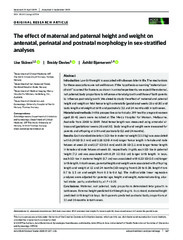The effect of maternal and paternal height and weight on antenatal, perinatal and postnatal morphology in sex-stratified analyses
Permanent lenke
https://hdl.handle.net/10037/17704Dato
2019-09-10Type
Journal articleTidsskriftartikkel
Peer reviewed
Sammendrag
Material and methods - In this prospective cohort study, 399 healthy pregnant women aged 20‐42 years were recruited at The Mercy Hospital for Woman, Melbourne, Australia from 2008 to 2009. Fetal femur length was measured using antenatal ultrasound (gestational weeks 20 and 30). Body length and weight were measured for parents and offspring at birth and postnatally (12 and 24 months).
Results - Each standard deviation (SD) rise in maternal weight (15.5 kg) was associated with 0.24 SD (0.5 mm) and 0.18 SD (0.4 mm) longer femur length in female and male fetuses at week 20 and 0.17 SD (0.5 mm) and 0.38 SD (1.1 mm) longer femur length in female and male fetuses at week 30, respectively. In girls, each SD rise in paternal height (7.2 cm) was associated with 0.29 SD (0.6 cm) longer birth length. In boys, each SD rise in maternal height (6.7 cm) was associated with 0.23 SD (0.5 cm) longer birth length. In both sexes, parental height and weight were associated with offspring length and weight at 12 and 24 months (SD ranging from 0.20 to 0.38, length from 0.7 to 1.5 cm and weight from 0.3 to 0.6 kg). The multivariable linear regression analyses were adjusted for parental age, height and weight, maternal smoking, alcohol intake, parity, and ethnicity, all P < 0.05.
Conclusions - Maternal, not paternal, body proportions determined fetal growth in both sexes. Paternal height predicted birth length in girls. In contrast, maternal height predicted birth length in boys. Both parents predicted postnatal body proportions at 12 and 24 months in both sexes.


 English
English norsk
norsk